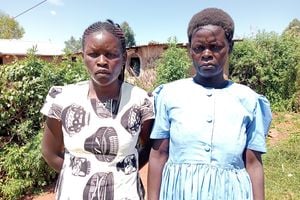Kangaroo care proves effective at Vihiga County Referral Hospital

Healthhcare workers are taken through newborn resuscitation procedure during an Early Essential Newborn Care (EENC) training in Vihiga on June 14, 2024. Resuscitation is needed to save babies who have diffciculty in breathing.
What you need to know:
- Some of the health workers, she says, also lacked knowledge on how to perform resuscitation procedures or offer kangaroo care to preterm babies.
- In cases of prolonged labour, Ms Mudambi notes that there is always a high chance the newborn could have either a high or low heart rate.
As Flavia Ndilani sits quietly on her bed at Vihiga County Referral Hospital postnatal ward, she holds one of her twin babies close to her chest. Lying fast asleep next to her is her other twin. For the past week, the hospital has been home to her and her babies. Flavia’s daily routine revolves around breastfeeding, practising kangaroo mother care and attending the health workers’ routine hospital rounds.
When she walked into the health centre in July, she had expected to undergo a normal check-up and return home. Then, she was 33 weeks pregnant. The doctors realised that she had dilated and was ready for a delivery. However, the babies were born preterm with one weighing 1,000 grams while the other weighed 1,340 grams. The newborns developed breathing complications and the facility was not well equipped to care for them.
“We were referred to the Vihiga County referral hospital and my babies were immediately moved to the newborn unit. I learnt that to help the babies gain weight, I had to practice kangaroo mother care which involved skin-to-skin contact with the babies, ” says Ms Ndilani. When Healthy Nation visited her, she had just been moved to the post-natal ward with the two babies weighing 1,840 and 1,900 grams respectively after a one-week stay at the facility.
At the wards, Ms Mercy Mudambi, a neonatal nurse moved from one bed to another, checking on mothers practicing kangaroo mother care. After attending to Ndilani, the nurse moved to another mother, Mildred Asiji who had also delivered twin boys and was referred to the facility. Ms Mudambi says that the babies were admitted to the newborn unit both weighing below 1.5 kilograms.
“The boys are currently weighing 1,740 and 1,650 grams respectively, the doctor also said once they get to two kilograms we can be discharged, ” offers Ms Asiji. According to the nurse in charge of the newborn unit, Vihiga County began training health workers in essential newborn care a few months ago to reduce child mortality. “Most of our staff lacked the knowledge on how to attend to women who went into early labour, prolonged labour, high-risk pregnancies and attending to premature babies, ” says Ms Mudambi.
Some of the health workers, she says, also lacked knowledge on how to perform resuscitation procedures or offer kangaroo care to preterm babies. In cases of prolonged labour, Ms Mudambi notes that there is always a high chance the newborn could have either a high or low heart rate. “Our health care workers are well prepared to perform the procedure. When done correctly, a newborn’s life is saved. We are guided by the golden minute policy that when not met, we might lose the baby,” she offers .
The World Health Organization (WHO) notes that in 2022, nearly half of all deaths in children under the age of five years occurred in the first 28 days of life. The report further revealed that Sub-Saharan Africa accounted for 57 per cent of the newborn-related deaths translating to 2.5 to three million of the total under-five deaths. Sub-Saharan Africa had the highest neonatal mortality rate in the world at 27 deaths per 1,000 live births.
The deaths according to the global health body resulted mainly from premature births, birth complications, neonatal infections and congenital anomalies. The 2014 Kenya Demographic Health Survey (KDHS) revealed that neonatal mortalities in Western Kenya stood at 19 per cent. Data from the latest KDHS report show that the county’s infant mortality per 1,000 live births currently stands at 34 per cent against the national 32 per cent.
The county’s under-five mortality rate per 1000 live births also stands at 51 per cent against the national statistic which is 41 per cent. Ms Veronica Musiga, the Vihiga County Reproductive Health Coordinator says the health workers mentorship programme has been running in the county with the support from the US Agency for International Development (USAID).
The health practitioner says the interventions were put in place to ensure that every mother who walks into the public health facilities to deliver eventually leaves with healthy babies.
“Before a baby is delivered, we prepare our labour wards so that they are warm enough, our key priorities being that they must be kept warm, fed and protected from infections, “says Ms Musiga.
Once born, the health workers have been trained to conduct skin-to-skin to keep them warm and initiate breastfeeding to protect the newborn from hypothermia. “We have currently mentored 30 health workers spread out in various health facilities,” offers the health coordinator. She mentioned that the initiative has boosted patients’ confidence in the health workers, while the county aims to reduce neonatal and under-five mortalities.
Meanwhile, the health practitioner has called for the employment of more midwives in county health facilities to assist with deliveries, even as Vihiga County’s skilled delivery rate is at 98 per cent, according to the 2022 KDHS report.
[email protected]



